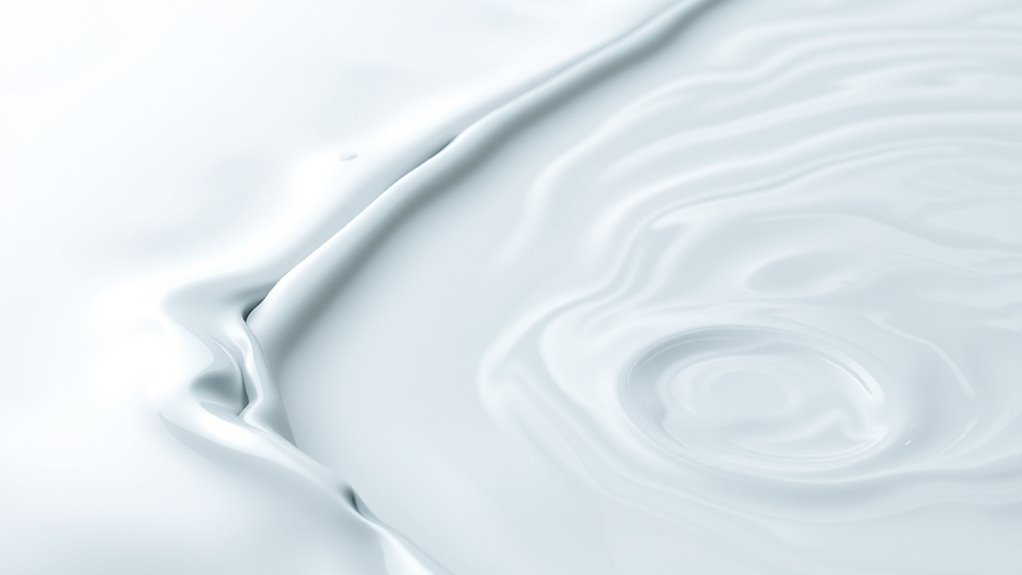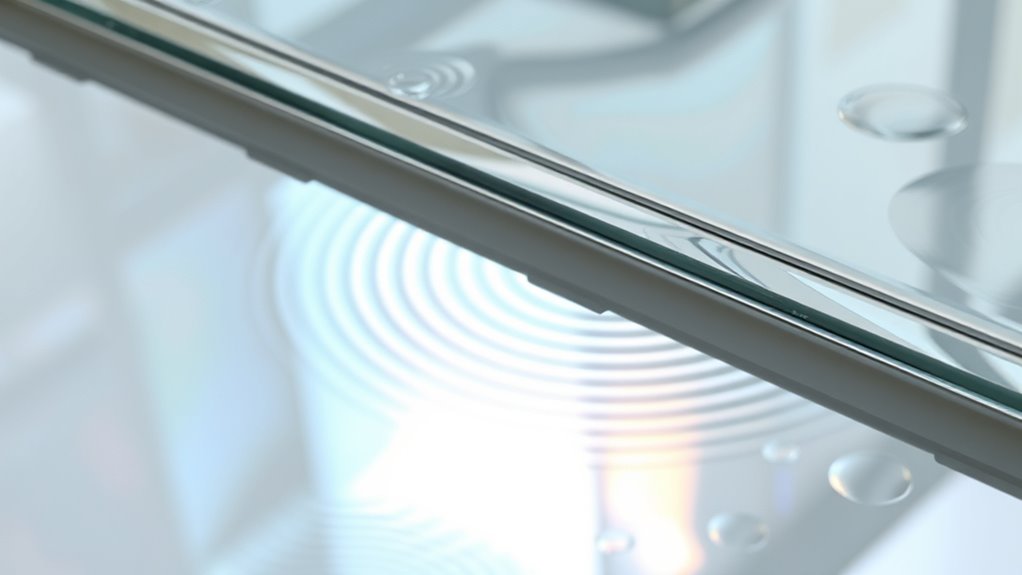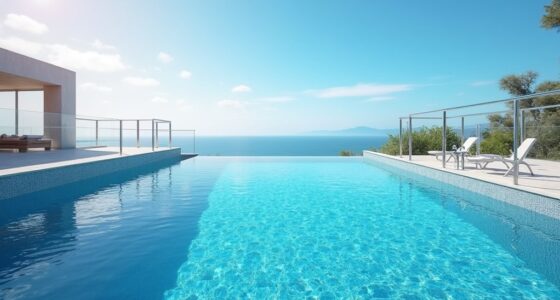Edge aesthetics like mirror reflections, delicate sheets, and notched spill patterns emerge from surface tension and substrate geometry. When liquids flow over specific edges, they form smooth, reflective surfaces or thin sheets that ripple or shimmer, creating striking visual effects. Notched edges generate serrated patterns caused by flow instabilities. Understanding these phenomena helps you appreciate how surface properties influence spill appearances, and exploring further reveals the fascinating science behind their unique beauty.
Key Takeaways
- Mirror effects in liquids depend on surface smoothness and low roughness, creating clear, reflective spill surfaces.
- Sheet spills at edges form thin, shimmering films influenced by flow rate, surface tension, and edge geometry.
- Notched spill patterns produce serrated, evenly spaced indentations caused by flow instabilities and surface irregularities.
- Surface tension and viscosity control edge stability, affecting the visual aesthetics of spill reflections and surface distortions.
- Surface features like roughness and notch design enhance or disrupt spill patterns, shaping their aesthetic and optical qualities.
Understanding the Mirror Effect in Liquid Spills

Have you ever noticed how a liquid spill on a smooth surface creates a mirror-like reflection? That’s because the surface’s low roughness allows light to bounce evenly, producing clear optical reflections. When the surface is exceptionally smooth, it minimizes optical distortions, making the liquid’s reflection sharp and almost perfect. However, even slight surface roughness can cause distortions, blurring the mirror effect and creating ripples or warps in the reflected image. Your ability to observe this depends on how polished or textured the surface is. The interplay between the liquid’s surface tension and the surface roughness determines the clarity of the reflection. So, the smoother the surface, the better the mirror effect, revealing the elegant beauty of liquid spills in everyday scenes.
Formation and Dynamics of Liquid Sheets at Edges

When a liquid flows over an edge, it naturally forms a thin, coherent sheet that extends outward before breaking up or merging with the surrounding environment. This liquid sheet’s formation is driven by surface tension and flow velocity, creating a dynamic, flexible structure. As light encounters the sheet, glass distortion and light refraction become evident, producing shimmering effects and visual distortions that highlight the sheet’s thinness. The edges act as focal points where curvature influences how light bends, enhancing the aesthetic appeal. The sheet’s stability depends on flow rate and surface tension, while its dynamics involve oscillations and thinning as it interacts with air and surface imperfections. This formation process produces mesmerizing visual phenomena, emphasizing the delicate balance between fluid mechanics and optical effects. Incorporating material properties into the analysis can further clarify how different liquids behave at edges, affecting the overall visual and physical characteristics of the sheets.
The Notched Spill Phenomenon: Characteristics and Causes

The notched spill phenomenon occurs when a liquid flowing over an edge develops a distinct, serrated pattern characterized by multiple, evenly spaced indentations or “notches.” This pattern arises from instabilities in the liquid sheet caused by surface tension variations, flow velocity fluctuations, and surface imperfections. Your edge design and surface roughness markedly influence these notches.
The notched spill pattern results from surface tension instabilities, flow variations, and surface imperfections affecting edge design.
- Irregularities in edge shape encourage localized flow disruptions, amplifying notching.
- Increased surface roughness creates uneven flow conditions, promoting serration.
- Sharp, textured edges tend to enhance the formation of evenly spaced notches.
- Variations in flow velocity at the edge heighten instability, intensifying the notched pattern.
Understanding these causes helps optimize edge design to control spill aesthetics effectively.
Surface Tension and Its Role in Edge Behavior

Surface tension influences how liquids form and maintain their edges, creating smooth and stable boundaries. You’ll notice capillary wave dynamics cause tiny ripples along these edges, affecting their appearance. Understanding meniscus formation principles helps you predict how liquids will behave at small scales, shaping the overall edge aesthetics. Additionally, surface tension effects play a crucial role in determining how different liquids interact at their boundaries, impacting the visual and functional qualities of edges.
Capillary Wave Dynamics
Capillary wave dynamics play a crucial role in shaping the behavior of edges by governing how surface tension influences the fluid’s surface. These waves respond directly to boundary curvature, affecting how the fluid deforms at edges. Your understanding of fluid viscosity helps clarify how quickly these waves dampen or propagate. Additionally, the high refresh rates of a projector can influence how smoothly moving images appear, which is an important aspect in visual presentations.
- Surface tension creates restoring forces that smooth out boundary curvature, maintaining edge stability.
- Waves form and travel along the surface, influenced by boundary curvature and fluid viscosity.
- Higher fluid viscosity slows wave motion, reducing edge oscillations.
- The interaction between surface tension and boundary curvature determines the amplitude and frequency of capillary waves, shaping how edges appear and behave.
Mastering these dynamics reveals how microscopic forces impact macroscopic edge aesthetics.
Meniscus Formation Principles
Meniscus formation occurs when surface tension forces fluid to minimize its surface area, causing it to curve at edges and boundaries. This curvature is influenced by the fluid’s viscosity; higher viscosity dampens surface fluctuations, creating a smoother meniscus. Color contrast at the edge can enhance the visibility of the meniscus, emphasizing its shape and behavior. When the boundary interacts with different surfaces, variations in surface tension cause distinct meniscus profiles, affecting spill effects and edge aesthetics. You’ll notice that fluids with lower viscosity form more pronounced curves, while those with higher viscosity produce gentler slopes. Incorporating visual contrast can help better observe these effects and improve the understanding of fluid dynamics at edges. Understanding these principles helps you predict how fluids behave at edges, enabling better control of spill effects and improving visual appeal in your designs or experiments.
The Influence of Surface Geometry on Spill Morphology

The geometry of a substrate dramatically shapes how liquids spread and form spills. Surface roughness influences spill shape by creating pinning points that slow or redirect flow. Material wettability determines whether a liquid beads or spreads smoothly across the surface. Recognizing how surface features impact spill morphology helps predict spill behavior, revealing the subtle interplay between surface roughness and material wettability. This knowledge enhances control over spill aesthetics and edge effects in fluid experiments.
Visual Signatures of Edge Effects in Fluid Experiments

You’ll notice how reflection patterns in mirrors reveal subtle edge effects that influence fluid behavior. Sheet spill dynamics highlight how edges guide flow and create distinctive patterns. Notched edges produce unique signatures, making them a key visual cue for understanding fluid interactions at boundaries. Additionally, the shape of edges can be studied using headphone jack compatibility to understand how boundary conditions affect flow visualization techniques.
Reflection Patterns in Mirrors
When examining mirror reflections in fluid experiments, distinct edge effects create recognizable visual signatures. You’ll notice how edge patterning influences spill visualization, shaping the reflected patterns uniquely. These signatures reveal how fluid interfaces interact with mirror boundaries. Additionally, understanding crochet styles for locs can inspire creative approaches to pattern design in fluid art techniques.
Sheet Spill Dynamics
Edge effects shape the visual signatures observed in sheet spill dynamics, revealing how fluid spreads along boundaries. You’ll notice that color contrast enhances these signatures, making the edges more distinct and highlighting the spill’s progression. Surface roughness plays an essential role, disrupting the smooth flow and creating textured patterns along the boundary. These variations influence how the fluid disperses, emphasizing the transition zones where spill effects are most pronounced. Sharp contrasts and surface irregularities generate unique visual cues, helping you identify the edge’s influence on the overall flow. By examining these signatures, you can better understand the interaction between fluid properties and boundary conditions. This insight sheds light on how edge effects shape the aesthetic and physical behavior of fluid sheets during spills. Inspirational quotes about fatherhood can serve as a reminder of the importance of guidance and support in shaping these dynamic interactions.
Notched Edge Signatures
Notched edges introduce distinct visual signatures in fluid experiments by creating localized disruptions along boundary lines. These notches alter the edge patterning, producing unique spill visualization effects. You’ll notice that the notches generate specific flow disturbances, making the spill patterns more complex. Additionally, understanding these edge effects can provide insights into fluid dynamics behavior and help in designing experiments for better flow control.
Practical Applications of Edge-Related Liquid Phenomena

The unique behaviors of liquids at edges and boundaries have found practical uses across various industries. Edge friction plays a pivotal role in controlling how liquids spread or resist movement along surfaces, which is essential in manufacturing and coating processes. For example, adjusting edge friction helps achieve precise paint lines or controlled fluid flow in microfluidic devices. Spill adhesion leverages the tendency of liquids to stick at edges, enhancing product durability or preventing unwanted leaks. In packaging, controlling spill adhesion ensures liquids stay confined, reducing waste. Additionally, understanding these edge phenomena improves the design of sealing materials and flow regulators. By harnessing edge friction and spill adhesion, industries can optimize performance, minimize waste, and develop more efficient, reliable liquid handling systems. Incorporating knowledge of dog names can also inspire innovative branding and product naming strategies that resonate with customers.
Techniques for Observing and Analyzing Spill Effects

To understand spill effects, you need reliable observation methods. Visual inspection techniques, spectral analysis, and simulation models provide different insights into how spills behave. Combining these approaches helps you analyze spill dynamics more accurately and develop effective aesthetic strategies.
Visual Inspection Techniques
Visual inspection techniques are essential for accurately observing and analyzing spill effects on surfaces. You’ll want to focus on subtle cues that reveal underlying phenomena. First, examine surface patterns for signs of quantum tunneling, which can cause unexpected spill spread at the microscopic level. Second, observe acoustic resonance effects, where specific spill shapes vibrate differently, indicating internal stress. Third, use magnification tools to detect minute surface distortions or notched edges that influence spill behavior. Lastly, compare spill reflections and distortions under varying lighting to identify asymmetries. These methods help you interpret complex interactions, ensuring precise analysis. Paying close attention to these visual cues enables you to better understand the physics behind spill effects, especially when phenomena like quantum tunneling and acoustic resonance play vital roles.
Spectral Analysis Methods
Have you considered how spectral analysis methods can reveal hidden details in spill effects that are invisible to the naked eye? By examining optical interference patterns, you can detect subtle variations in the spill’s structure, colors, and boundaries. These techniques allow you to analyze dye diffusion more precisely, showing how dyes spread and interact over time. Spectral analysis captures the wavelength-specific information, helping you distinguish overlapping spill layers and identify inconsistencies. This approach enhances your understanding of spill dynamics, making it easier to quantify edge sharpness and the extent of diffusion. Ultimately, spectral methods provide a deeper insight into the complex behaviors of spill effects, revealing details that standard visual inspection can’t uncover.
Simulation and Modeling
How can simulation and modeling techniques transform your understanding of spill effects? These tools allow you to visualize complex interactions at the edge, like quantum tunneling and microbial adhesion. By simulating spill dynamics, you can:
- Predict how spills spread across surfaces, considering quantum tunneling effects at microscopic levels.
- Analyze microbial adhesion patterns that influence spill persistence and contamination risks.
- Test different edge designs virtually, reducing trial-and-error in physical experiments.
- Refine your models based on real-time data, improving accuracy in predicting spill behavior.
Using advanced algorithms, you can observe spill phenomena that are difficult to study directly, giving you deeper insights into edge aesthetics and spill mitigation strategies. This approach enhances precision and saves time.
Manipulating Edge Effects for Material Coatings

Manipulating edge effects in material coatings enables precise control over surface properties and performance. By adjusting edge geometries, you can influence optical illusions and surface acoustics, enhancing visual depth or sound absorption. For example, notched edges can create reflective illusions, making surfaces appear larger or more dynamic. Sheet edges can diffuse light, improving clarity or reducing glare. Notches disrupt surface acoustics, dampening noise or directing sound waves. Use the table below to explore different edge modifications and their effects:
| Edge Type | Effect | Application | Key Benefit | Example |
|---|---|---|---|---|
| Mirror | Reflects light for illusions | Decorative surfaces | Visual depth enhancement | Facade panels |
| Sheet | Diffuses light and sound | Acoustic treatments | Noise reduction | Concert halls |
| Notched | Disrupts surface acoustics | Soundproofing | Damping unwanted noise | Office partitions |
| Rounded | Softens edge, improves surface flow | Wear-resistant coatings | Reduced wear and tear | Automotive trims |
| Sharp | Focused optical and acoustic effects | Precision instruments | Enhanced performance | Optical lenses |
Future Directions in the Study of Liquid Edge Dynamics

Advances in imaging techniques and computational modeling are paving the way for a deeper understanding of liquid edge dynamics. These tools allow you to explore how edge influence shapes fluid behavior and how fluid anisotropy affects spill patterns. Future research can focus on:
- Analyzing how edge influence varies with different substrate geometries.
- Investigating the role of fluid anisotropy in determining spill stability.
- Developing models to predict edge effects in complex liquid systems.
- Exploring how dynamic edge interactions impact coating and film formation.
Frequently Asked Questions
How Do Temperature Variations Influence Edge Spill Effects?
Temperature variations cause thermal fluctuations that substantially influence edge spill effects. As temperatures change, surface tension varies, altering how liquids spread or retract at edges. Higher temperatures typically decrease surface tension, leading to more pronounced spill effects, while cooler temperatures increase surface tension, reducing spill extent. You’ll notice these shifts as the liquid’s behavior adapts to thermal fluctuations, impacting the overall edge aesthetics and spill dynamics.
Can Edge Effects Be Used to Control Liquid Flow in Microfluidic Devices?
Yes, you can use edge effects for microfluidic control through surface patterning. By designing specific edge geometries, you direct liquid flow precisely, leveraging spill effects to guide or contain fluids. This method enhances microfluidic device efficiency, allowing you to manipulate tiny liquid volumes accurately. Surface patterning creates tailored edge effects that serve as barriers or pathways, making fluid control more reliable and customizable for various applications.
What Role Do Impurities Play in Shaping Spill Edge Phenomena?
Impurities play a essential role in shaping spill edge phenomena by affecting impurity interactions and surface contamination. They can alter surface tension and wettability, leading to irregular spill edges. When impurities settle on surfaces, they create heterogeneities that influence how liquids spread and form spill patterns. Recognizing these effects helps you control spill behavior more precisely, especially in applications where surface cleanliness and impurity management are critical for consistency.
Are There Environmental Factors That Significantly Alter Edge Aesthetics?
You might think environmental factors are negligible, but ironically, pollutants and ambient humidity dramatically shape spill edge aesthetics. Environmental pollutants can introduce unexpected textures and colors, turning a clean spill into chaos. Humidity influences how liquids spread, often creating shimmering, mirror-like effects or unpredictable notched edges. So, next time you admire spill effects, remember, the environment isn’t just a backdrop—it’s an active artist in the process.
How Do Different Liquid Viscosities Affect the Formation of Mirror and Sheet Effects?
Different liquid viscosities markedly impact effect formation by altering spill dynamics and surface tension. Higher viscosity liquids tend to create smoother, more stable mirror and sheet effects, as their resistance slows spreading and maintains cohesive surfaces. Conversely, lower viscosity liquids spread quickly, producing less defined effects. Adjusting viscosity allows you to control the spill’s appearance and stability, influencing how the mirror and sheet effects develop during the spill.
Conclusion
Think of these edge effects as a dance where each movement shapes the story—mirrors reflect, sheets cascade, and notches carve identity. By understanding their rhythm, you can choreograph surfaces with precision, turning fleeting spills into lasting artistry. Embrace these fluid melodies, for mastering their dance reveal new horizons in material design and innovation. Let the edge be your stage, and your actions the choreography that transforms liquid chaos into elegant harmony.









